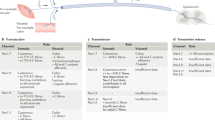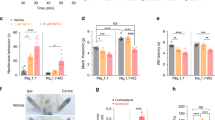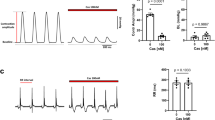Abstract
Neurotransmitter release from mammalian sensory neurons is controlled by CaV2.2 N-type calcium channels. N-type channels are a major target of neurotransmitters and drugs that inhibit calcium entry, transmitter release and nociception through their specific G protein–coupled receptors. G protein–coupled receptor inhibition of these channels is typically voltage-dependent and mediated by Gβγ, whereas N-type channels in sensory neurons are sensitive to a second G protein–coupled receptor pathway that inhibits the channel independent of voltage. Here we show that preferential inclusion in nociceptors of exon 37a in rat Cacna1b (encoding CaV2.2) creates, de novo, a C-terminal module that mediates voltage-independent inhibition. This inhibitory pathway requires tyrosine kinase activation but not Gβγ. A tyrosine encoded within exon 37a constitutes a critical part of a molecular switch controlling N-type current density and G protein–mediated voltage-independent inhibition. Our data define the molecular origins of voltage-independent inhibition of N-type channels in the pain pathway.
This is a preview of subscription content, access via your institution
Access options
Subscribe to this journal
Receive 12 print issues and online access
$209.00 per year
only $17.42 per issue
Buy this article
- Purchase on Springer Link
- Instant access to full article PDF
Prices may be subject to local taxes which are calculated during checkout








Similar content being viewed by others
References
Bourinet, E. & Zamponi, G.W. Voltage gated calcium channels as targets for analgesics. Curr. Top. Med. Chem. 5, 539–546 (2005).
Dunlap, K. & Fischbach, G.D. Neurotransmitters decrease the calcium conductance activated by depolarization of embryonic chick sensory neurones. J. Physiol. (Lond.) 317, 519–535 (1981).
Holz, G.G., IV, Rane, S.G. & Dunlap, K. GTP-binding proteins mediate transmitter inhibition of voltage-dependent calcium channels. Nature 319, 670–672 (1986).
Taddese, A., Nah, S.Y. & McCleskey, E.W. Selective opioid inhibition of small nociceptive neurons. Science 270, 1366–1369 (1995).
Polo-Parada, L. & Pilar, G. κ- and μ-opioids reverse the somatostatin inhibition of Ca2+ currents in ciliary and dorsal root ganglion neurons. J. Neurosci. 19, 5213–5227 (1999).
Ossipov, M.H., Lai, J., Malan, T.P., Jr & Porreca, F. Spinal and supraspinal mechanisms of neuropathic pain. Ann. NY Acad. Sci. 909, 12–24 (2000).
Bean, B.P. Neurotransmitter inhibition of neuronal calcium currents by changes in channel voltage dependence. Nature 340, 153–156 (1989).
Ikeda, S.R. Voltage-dependent modulation of N-type calcium channels by G-protein βγ subunits. Nature 380, 255–258 (1996).
Herlitze, S. et al. Modulation of Ca2+ channels by G-protein βγ subunits. Nature 380, 258–262 (1996).
Ikeda, S.R. & Dunlap, K. Voltage-dependent modulation of N-type calcium channels: role of G protein subunits. Adv. Second Messenger Phosphoprotein Res. 33, 131–151 (1999).
Diverse-Pierluissi, M. & Dunlap, K. Distinct, convergent second messenger pathways modulate neuronal calcium currents. Neuron 10, 753–760 (1993).
Elmslie, K.S. Neurotransmitter modulation of neuronal calcium channels. J. Bioenerg. Biomembr. 35, 477–489 (2003).
Park, D. & Dunlap, K. Dynamic regulation of calcium influx by G-proteins, action potential waveform, and neuronal firing frequency. J. Neurosci. 18, 6757–6766 (1998).
Delmas, P., Coste, B., Gamper, N. & Shapiro, M.S. Phosphoinositide lipid second messengers: new paradigms for calcium channel modulation. Neuron 47, 179–182 (2005).
Strock, J. & Diverse-Pierluissi, M.A. Ca2+ channels as integrators of G protein-mediated signaling in neurons. Mol. Pharmacol. 66, 1071–1076 (2004).
Diverse-Pierluissi, M., Remmers, A.E., Neubig, R.R. & Dunlap, K. Novel form of crosstalk between G protein and tyrosine kinase pathways. Proc. Natl. Acad. Sci. USA 94, 5417–5421 (1997).
Bell, T.J., Thaler, C., Castiglioni, A.J., Helton, T.D. & Lipscombe, D. Cell-specific alternative splicing increases calcium channel current density in the pain pathway. Neuron 41, 127–138 (2004).
Castiglioni, A.J., Raingo, J. & Lipscombe, D. Alternative splicing in the C-terminus of CaV2.2 controls expression and gating of N-type calcium channels. J. Physiol. (Lond.) 576, 119–134 (2006).
Li, B., Zhong, H., Scheuer, T. & Catterall, W.A. Functional role of a C-terminal Gβγ-binding domain of Cav2.2 channels. Mol. Pharmacol. 66, 761–769 (2004).
Hamid, J. et al. Identification of an integration center for cross-talk between protein kinase C and G protein modulation of N-type calcium channels. J. Biol. Chem. 274, 6195–6202 (1999).
Qin, N., Platano, D., Olcese, R., Stefani, E. & Birnbaumer, L. Direct interaction of Gβγ with a C-terminal Gβγ-binding domain of the Ca2+ channel α1 subunit is responsible for channel inhibition by G protein-coupled receptors. Proc. Natl. Acad. Sci. USA 94, 8866–8871 (1997).
Hille, B. et al. Multiple G-protein-coupled pathways inhibit N-type Ca channels of neurons. Life Sci. 56, 989–992 (1995).
Elmslie, K.S., Zhou, W. & Jones, S.W. LHRH and GTP-γ-S modify calcium current activation in bullfrog sympathetic neurons. Neuron 5, 75–80 (1990).
Luebke, J.I. & Dunlap, K. Sensory neuron N-type calcium currents are inhibited by both voltage-dependent and -independent mechanisms. Pflugers Arch. 428, 499–507 (1994).
Diverse-Pierluissi, M., Inglese, J., Stoffel, R.H., Lefkowitz, R.J. & Dunlap, K. G protein-coupled receptor kinase mediates desensitization of norepinephrine-induced Ca2+ channel inhibition. Neuron 16, 579–585 (1996).
Fujikawa, S., Motomura, H., Ito, Y. & Ogata, N. GABAB-mediated upregulation of the high-voltage-activated Ca2+ channels in rat dorsal root ganglia. Pflugers Arch. 434, 84–90 (1997).
Diverse-Pierluissi, M., Goldsmith, P.K. & Dunlap, K. Transmitter-mediated inhibition of N-type calcium channels in sensory neurons involves multiple GTP-binding proteins and subunits. Neuron 14, 191–200 (1995).
Kammermeier, P.J. & Ikeda, S.R. Expression of RGS2 alters the coupling of metabotropic glutamate receptor 1a to M-type K+ and N-type Ca2+ channels. Neuron 22, 819–829 (1999).
Richman, R.W. & Diverse-Pierluissi, M.A. Mapping of RGS12-Cav2.2 channel interaction. Methods Enzymol. 390, 224–239 (2004).
Brugge, J.S. et al. Neurones express high levels of a structurally modified, activated form of pp60c-src. Nature 316, 554–557 (1985).
Onofri, F. et al. Synapsin I interacts with c-Src and stimulates its tyrosine kinase activity. Proc. Natl. Acad. Sci. USA 94, 12168–12173 (1997).
Brody, D.L. & Yue, D.T. Relief of G-protein inhibition of calcium channels and short-term synaptic facilitation in cultured hippocampal neurons. J. Neurosci. 20, 889–898 (2000).
Altier, C. et al. ORL1 receptor-mediated internalization of N-type calcium channels. Nat. Neurosci. 9, 31–40 (2006).
Rane, S.G. & Dunlap, K. Kinase C activator 1,2-oleoylacetylglycerol attenuates voltage-dependent calcium current in sensory neurons. Proc. Natl. Acad. Sci. USA 83, 184–188 (1986).
Tombler, E. et al. G protein-induced trafficking of voltage-dependent calcium channels. J. Biol. Chem. 281, 1827–1839 (2006).
Richman, R.W. et al. N-type Ca2+ channels as scaffold proteins in the assembly of signaling molecules for GABAB receptor effects. J. Biol. Chem. 279, 24649–24658 (2004).
Lipscombe, D. & Raingo, J. Internalizing channels: a mechanism to control pain? Nat. Neurosci. 9, 8–10 (2006).
Bonifacino, J.S. & Traub, L.M. Signals for sorting of transmembrane proteins to endosomes and lysosomes. Annu. Rev. Biochem. 72, 395–447 (2003).
Roche, K.W. et al. Molecular determinants of NMDA receptor internalization. Nat. Neurosci. 4, 794–802 (2001).
Lin, Z., Haus, S., Edgerton, J. & Lipscombe, D. Identification of functionally distinct isoforms of the N-type Ca2+ channel in rat sympathetic ganglia and brain. Neuron 18, 153–166 (1997).
Lin, Y., McDonough, S.I. & Lipscombe, D. Alternative splicing in the voltage-sensing region of N-type CaV2.2 channels modulates channel kinetics. J. Neurophysiol. 92, 2820–2830 (2004).
Thaler, C., Gray, A.C. & Lipscombe, D. Cumulative inactivation of N-type CaV2.2 calcium channels modified by alternative splicing. Proc. Natl. Acad. Sci. USA 101, 5675–5679 (2004).
Roussel, R.R., Brodeur, S.R., Shalloway, D. & Laudano, A.P. Selective binding of activated pp60c-src by an immobilized synthetic phosphopeptide modeled on the carboxyl terminus of pp60c-src. Proc. Natl. Acad. Sci. USA 88, 10696–10700 (1991).
Acknowledgements
We are grateful to S. Denome for technical assistance, K. Dunlap (Tufts University) for GABABR1a and GABABR2 cDNA clones, L. Devi (New York University) for the μ-opioid receptor cDNA clone and S.R. Ikeda (US National Institutes of Health) for the MAS-GRK-ct cDNA clone. This work was supported by US National Institutes of Health grants NS29967 and NS55251 (D.L.).
Author information
Authors and Affiliations
Contributions
All authors contributed to writing the manuscript. D.L. directed the project. J.R. performed experiments and analyses for all figures. A.J.C. originally identified the tyrosine kinase sites in e37a, contributed to the design and construction of the tyrosine mutants, and performed the sequence analysis in Figure 8a.
Corresponding author
Ethics declarations
Competing interests
The authors declare no competing financial interests.
Supplementary information
Supplementary Fig. 1
Time course of μ-opioid receptor? and GABAB receptor–mediated inhibition of CaV2.2 currents. (PDF 18 kb)
Supplementary Fig. 2
Voltage-independent but not voltage-dependent inhibition mediated by GABAB receptor activation is prevented by pp60c-src tyrosine kinase peptide inhibitor. (PDF 47 kb)
Supplementary Table 1
Averaged parameters estimated from Boltzmann linear fits of current-voltage relationships. (PDF 55 kb)
Rights and permissions
About this article
Cite this article
Raingo, J., Castiglioni, A. & Lipscombe, D. Alternative splicing controls G protein–dependent inhibition of N-type calcium channels in nociceptors. Nat Neurosci 10, 285–292 (2007). https://doi.org/10.1038/nn1848
Received:
Accepted:
Published:
Issue Date:
DOI: https://doi.org/10.1038/nn1848
This article is cited by
-
Opioid Receptor Regulation of Neuronal Voltage-Gated Calcium Channels
Cellular and Molecular Neurobiology (2021)
-
Further identification of a 140bp sequence from amid intron 9 of human FMR1 gene as a new exon
BMC Genetics (2020)
-
Ghrelin Selectively Inhibits CaV3.3 Subtype of Low-Voltage-Gated Calcium Channels
Molecular Neurobiology (2020)
-
Differential regulation of Cav2.2 channel exon 37 variants by alternatively spliced μ-opioid receptors
Molecular Brain (2019)
-
Cacna1b alternative splicing impacts excitatory neurotransmission and is linked to behavioral responses to aversive stimuli
Molecular Brain (2019)



